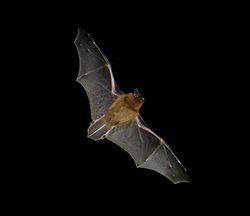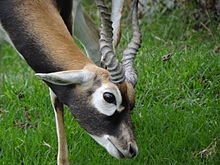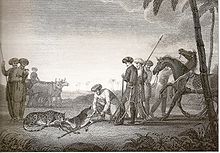The
blackbuck (
pronounced /ˈblak-ˌbək/;
Antilope cervicapra), also known as the
Indian antelope, is an
antelope found in
India and
Nepal. The blackbuck is the sole extant member of the
genus Antilope. The
species was
described and given its binomial name by Swedish zoologist
Carl Linnaeus in 1758. Two
subspecies
are recognised. It stands up to 74 to 84 cm (29 to 33 in) high at the
shoulder. Males weigh 20–57 kilograms (44–126 lb), an average of 38
kilograms (84 lb). Females are lighter, weighing 20–33 kilograms
(44–73 lb) or 27 kilograms (60 lb) on an average. The long, ringed
horns,
35–75 centimetres (14–30 in) long, are generally present only on males,
though females may develop horns as well. The white fur on the chin and
around the eyes is in sharp contrast with the black stripes on the
face. The coat of males shows two-tone colouration: while the upper
parts and outsides of the legs are dark brown to black, the underparts
and the insides of the legs are all white. On the other hand, females
and juveniles are yellowish fawn to tan.
The blackbuck is a
diurnal
antelope (active mainly during the day). Three kinds of groups,
typically small, are the female, male and bachelor herds. Males often
adopt
lekking
as a strategy to garner females for mating. While other males are not
allowed into these territories, females often visit these places to
forage. The male can thus attempt mating with her. Herbivores, blackbuck
graze on low grasses, occasionally
browsing as well. Females become
sexually mature
at eight months, but mate no earlier than two years. Males mature
later, at one-and-a-half years. Mating takes place throughout the year.
Gestation is typically six months long, after which a single calf is
born. The lifespan is typically 10 to 15 years.
The blackbuck inhabits grassy plains and slightly forested areas. Due
to their regular need of water, they prefer areas where water is
perennially available.
The antelope is native to and found mainly in India, while it is
extinct in
Bangladesh.
Formerly widespread, only small, scattered herds are seen today,
largely confined to protected areas. During the 20th century, blackbuck
numbers declined sharply due to excessive hunting, deforestation and
habitat degradation. The blackbuck has been introduced in
Argentina and the United States. The International Union for the Conservation of Nature and Natural Resources (
IUCN) lists the blackbuck as
Near Threatened. In India, hunting of blackbuck is prohibited under Schedule I of the
Wildlife Protection Act of 1972. The blackbuck has significance in
Hinduism; Indian and Nepali villagers do not harm the antelope.

Etymology

The scientific name of the blackbuck is Antilope cervicapra. Its generic name stems from the Latin word antalopus ("horned animal").[2][3] The specific name cervicapra is composed of the Latin words cervus ("deer") and capra ("she-goat").[2][4] The vernacular name "blackbuck" (pronounced /ˈblak-ˌbək/) is a reference to the dark brown to black colour of the dorsal (upper) part of the coat of the male.[5] The earliest recorded use of this name dates back to 1850.[6] Alternative names for the blackbuck are "Indian antelope",[7] kadiyal, kala hiran, krishna mrig and krishnasaar (in Hindi); krishna jinka (in Telugu); and iralai maan (in Tamil).[8][9][10]

Taxonomy and evolution

The blackbuck is the sole member of the
genus Antilope and is classified under the
family Bovidae. The
species was
described and given its binomial name by Swedish zoologist
Carl Linnaeus in the
10th edition of Systema Naturae in 1758.
[11][12] Antilope also includes
fossil species, such as
A. subtorta,
A. planicornis, and
A. intermedius.
[13]
Antilope,
Eudorcas,
Gazella and
Nanger form a
clade within their
tribe Antilopini. A 1995 study of the detailed
karyotype of
Antilope suggested that within this clade,
Antilope is closest to the
Gazella group.
[14] A 1999
phylogenetic analysis confirmed that
Antilope is the closest sister taxon to
Gazella,
[15] although an earlier phylogeny, proposed in 1976, placed
Antilope as sister to
Nanger.
[16] In a more recent revision of the phylogeny of Antilopini on the basis of sequences from multiple
nuclear and
mitochondrial loci in 2013, Eva Verena Bärmann (of the
University of Cambridge) and colleagues reexamined the phylogenetic relationships and found
Antilope and
Gazella to be sister genera distinct from the sister genera
Nanger and
Eudorcas.
[17][18]
Two
subspecies are recognised,
[19][20] although they might be independent species:
[21]
- A. c. cervicapra (Linnaeus, 1758) : Known as the southeastern blackbuck. Occurs in southern, eastern and central India. The white eye ring of the male is narrow above the eye and the leg stripe is well defined and reaches all along the leg.
- A. c. rajputanae Zukowsky, 1927 : Known as the
northwestern blackbuck. Occurs in northwestern India. Males have a grey
sheen to the dark parts during the breeding season. The white eye ring
is broad all around the eye with the leg-stripe going only down to the
shanks.

Genetics

The blackbuck shows variation in its diploid
chromosome number. Males have 31-33 while females have 30-32. Males have a XY1Y2 sex chromosome.
[21][22] Unusually large
sex chromosomes had earlier been described only in a few species, all of which belonged to Rodentia. However, in 1968, a study found that two
artiodactyls, the blackbuck and the
sitatunga, too showed this abnormality. Generally the
X chromosome constitutes 5 percent of the
haploid
chromosomal complement; but the X chromosome of the blackbuck this
percentage is 14.96. Portions of both peculiarly large chromosomes show
delayed
replication.
[23]
A 1997 study found lower
protein polymorphism in
Antilope in comparison with
Antidorcas,
Eudorcas and
Gazella. This was attributed to a history of rapid evolution of an
autapomorphic phenotype of
Antilope. This might have been aided by a particularly strong selection of a few dominant males due to its lekking behaviour.
[24]

Description
| Blackbuck – male and female |
|
|
The blackbuck is a moderately sized
antelope. It stands up to 74 to 84 cm (29 to 33 in) high at the shoulder; the head-to-body length is nearly 120 cm (47 in).
[12]
In the population introduced to Texas, males weigh 20–57 kilograms
(44–126 lb), an average of 38 kilograms (84 lb). Females are lighter,
weighing 20–33 kilograms (44–73 lb) or 27 kilograms (60 lb) on an
average.
[25] Sexual dimorphism is prominent, as males are heavier and darker than the females.
[25] The long, ringed
horns,
that resemble corkscrews, are generally present only on males, though
females may develop horns as well. They measure 35–75 centimetres
(14–30 in), though the maximum horn length recorded in Texas has not
exceeded 58 centimetres (23 in). The horns diverge forming a "V"-like
shape.
[25] In
India, horns are longer and more divergent in specimens from the northern and western parts of the country.
[20]
The white fur on the chin and around the eyes is in sharp contrast
with the black stripes on the face. The coat of males shows two-tone
colouration: while the upper parts and outsides of the legs are dark
brown to black, the underparts and the insides of the legs are all
white. Darkness typically increases as the male ages.
[26] On the other hand, females and juveniles are yellowish fawn to tan.
[26] In
Texas, blackbuck
moult in spring, following which the males look notably lighter, though darkness persists on the face and the legs.
[25] On the contrary, males will grow darker as the breeding season approaches.
[26] Both melanism
[27] and albinism have been observed in wild blackbuck. Albino blackbuck are often zoo attractions as in the
Indira Gandhi Zoological Park (Andhra Pradesh, India).
[28]
Blackbuck bear a close resemblance to gazelles, and are distinguished
mainly by the fact that while gazelles are brown in the dorsal parts,
blackbuck develop a dark brown or black colour in these parts.
[5]
Ecology and behaviour
The blackbuck is a
diurnal antelope (active mainly during the day), though activity slows down at noon as days grow hotter toward summer.
[12] Three kinds of typically small groups – the female herds,
territorial males and bachelor males.
[25]
A study discovered that group sizes often fluctuate; membership is
often dictated by availability of forage and the nature of the habitat.
Large herds have an edge over smaller ones in that danger can be
detected faster, though individual vigilance is lower in the former.
Greater time is spent in feeding by large herds. A disadvantage for
large herds, however, is that traveling requires more resources.
[29] A study found that herd size reduces in summer.
[9] Fast animals, the blackbuck can run at as high as 80 kilometres per hour (50 mph).
[12]
Males often adopt
lekking
as a strategy on the part of males to garner females for mating.
Territories are established by males on the basis of the local
distribution of female groups, which in turn is determined by the
habitat, so as to ensure greater access to females.
[30] The males actively defend resources in their territories, nearly 1.2 to 12 hectares (3.0 to 29.7 acres) in size;
[25] territories are marked with scent (using
preorbital gland and
interdigital gland secretions, faeces and urine)
[31][32]
While other males are not allowed into these territories, females are
allowed to visit these places to forage. The male can attempt mating
with visiting females. Lekking is a demanding strategy, as the males
often have to bear injuries – thus it is a tactic typically adopted by
strong,
dominant
males. Males may either defend their mates or try to forcibly copulate
with them. Weaker males, who may not be dominant, might choose the
second method.
[33]
Blackbuck are severely affected by natural calamities such as floods
and droughts, from which they can take as long as five years to recover.
[34] Wolves are major
predators;
[35] a study found that old rutting bulls might be vulnerable to wolves.
[34] Cheetahs and
pariah dogs are the other predators.
[5] Juveniles are also hunted by
jackals. Village dogs are reported to kill fawns, but are unlikely to successfully hunt and kill adults.
[36]
Diet
Blackbuck prefer grasses.
Being herbivores, blackbuck graze on low grasses, occasionally
browsing as well. They prefer
sedges,
fall witchgrass,
mesquite, and
live oak. They have occasionally been observed browsing on
acacia trees in the
Cholistan Desert.
[37] Oats and berseem were found to be palatable and nutritious to captive populations in a study.
[38] A study in the
Velavadar Black Buck Sanctuary (
Gujarat, India) showed that
Dichanthium annulatum comprised 35 percent of their diet. Digestion of nutrients, especially
crude proteins,
was poor in summer, but more efficient in the rainy and winter seasons.
Consequently crude protein intake in summer was very low, even below
the recommended value. Blackbuck had a lower food consumption in summer.
The fruits of
Prosopis juliflora are often eaten, and blackbuck may play a role in their dispersal.
[39] Prosopis becomes a significant food item if grasses are scarce.
[40] Water is a daily requirement of the blackbuck.
[1]
Reproduction
Courtship display in blackbuck
Females become
sexually mature
at eight months, but mate no earlier than two years. Males mature
later, at one-and-a-half years. Mating takes place throughout the year;
peaks occur during spring and fall in Texas.
[25] Two peaks have been observed in India: from August to October and from March to April.
[9]
Rutting males aggressively establish and defend their territories from
other males, giving out loud grunts and engaging in serious head-to-head
fights, pushing each other using horns.
[12] Aggressive
display
consists of thrusting the neck forward and raising it, folding the ears
and raising the tail. The dominant male pursues the female with his
nose pointing upward, smells her urine and shows a
flehmen
response. The female shows her receptivity by waving her tail and
thumping the hindlegs on the ground. This is followed by several
mounting attempts, and copulation. The whole process may last as long as
six hours. The female will remain still for some time after copulation,
following which she may start grazing. The male may then move on to
mate with another female.
[9][41]
Gestation is typically six months long,
[42] after which a single calf is born.
[25] Newborn are a light yellow; infant males may have a black patch on the head and the neck.
[9] Young are
precocial - they can stand on their own soon after birth.
[12] Females can mate again after a month of parturition.
[25]
Juveniles remain active and playful throughout the day. Juvenile males
turn black gradually, darkening notably after the third year.
[9] The lifespan is typically 10 to 15 years.
[5][25]
Habitat and distribution
Blackbuck prefer grassy plains.
The blackbuck inhabits grassy plains and thinly forested areas.
Scrublands are a good source of forage and cover.
[26]
Due to their regular need for water, they prefer areas where perennial
water sources are available. Though sedentary, blackbuck may travel long
distances to obtain water.
[1] Cold climates do not suit the blackbuck.
[26] In the
Indian subcontinent,
blackbuck can also be found in deserts (in the northwestern region),
coastal areas, mountains (in the northern-northeastern region).
[1][25]
The antelope is native to and found mainly in India, while it is
extinct in
Bangladesh.
[1] Today, only small, scattered herds are seen, largely confined to protected areas.
[43] English naturalist
William Thomas Blanford, in his 1891
The Fauna of British India, including Ceylon and Burma, described the range of the blackbuck in those times as:
[11]
Along the base of the Himalayas from the Punjab to Nepal, and
probably in most parts of the Peninsula where the country is wooded and
hilly, but not in dense jungle ... it is common in the wooded parts of
Rajputana, throughout the Bombay Presidency, the Central Provinces, and
the northern parts of Madras, less abundant to the eastward in
Chhattisgarh, Chutia Nagpur [sic], Bengal and Orissa, and to the
southward in Mysore, but it occurs in the latter state occasionally, and
has been observed on the Nilgiri and Palni hills. It is unknown in
Ceylon and east of the Bay of Bengal.
Pair of blackbucks in Rehekuri Blackbuck Sanctuary (Maharashtra, India)
In
Nepal, the last surviving population of blackbuck is found in the
Blackbuck Conservation Area south of the
Bardia National Park. In 2008, the population was estimated at 184.
[44] In
Pakistan, blackbuck occasionally occur along the border with India and a captive population is maintained in the
Lal Suhanra National Park.
[37] The antelope was introduced in
Texas in the
Edwards Plateau in 1932. By 1988, the population had increased and the antelope was the most populous exotic animal in Texas after the
chital.
[25][45] As of early 2000s, the population in the United States has been estimated at 35,000. Blackbuck have been introduced into
Argentina, numbering about 8,600 individuals (as of the early 2000s).
[37]
Threats and conservation
During
the 20th century, blackbuck numbers declined sharply due to excessive
hunting, deforestation and habitat degradation. Some blackbucks are
killed illegally especially where they are
sympatric with
nilgai.
[1] Until
India's independence in 1947, blackbuck and
chinkara were hunted in many
princely states with specially trained captive
Asiatic cheetahs.
[43] By the 1970s, blackbuck were extinct in several areas.
[46] Nevertheless, populations in India have increased from 24,000 in the late 1970s to 50,000 in 2001
[citation needed]. The International Union for the Conservation of Nature and Natural Resources (
IUCN) lists the blackbuck as
Near Threatened.
[1] CITES (
Washington Convention) lists the blackbuck under
Appendix III (Nepal).
[19]
In India, hunting of blackbuck is prohibited under Schedule I of the
Wildlife Protection Act of 1972.
[10][47] They occur in several
protected areas of India, including:
Kaimur Wildlife Sanctuary (Bihar);
Gir Forest National Park[48] and Velavadar Wildlife Sanctuary (Gujarat);
Ranibennur Blackbuck Sanctuary (Karnataka);
Great Indian Bustard Sanctuary (Maharashtra);
National Chambal Sanctuary,
Ranthambhore National Park[49] and
Tal Chhapar Sanctuary (Rajasthan);
Guindy National Park,
Point Calimere Wildlife and Bird Sanctuary and
Vallanadu Wildlife Sanctuary[50] (
Tamil Nadu).
[1][37]

Interaction with human beings
The blackbuck has associations with the
Indian culture. The antelope might have been a source of food in the
Indus Valley civilisation (3300–1700 BCE); bone remains have been discovered in sites such as
Dholavira[51] and
Mehrgarh.
[52] The blackbuck is routinely depicted in miniature paintings of the
Mughal era (16th to 19th centuries) depicting royal hunts often using cheetahs.
[53][54][55] Villagers in India and Nepal generally do not harm the blackbuck.
[56] Tribes such as the
Bishnois revere and care for most animals including the blackbuck.
[10][57] The blackbuck has been declared as the state animal of Andhra Pradesh.
[8]
The animal is mentioned in
Sanskrit texts as the
krishna mrig.
[10] According to
Hindu mythology, the blackbuck draws the chariot of
Lord Krishna.
[56] The blackbuck is considered to be the vehicle of
Vayu (the wind god),
Soma (the divine drink) and
Chandra (the moon god).
[10] In Tamil Nadu, the blackbuck is considered to be the vehicle of the Hindu goddess
Korravai.
[57] In Rajasthan, the goddess
Karni Mata is believed to protect the blackbuck.
[57]
In the
Yājñavalkya Smṛti,
Sage Yagyavalkya is quoted stating "
in what country there is black antelope, in that Dharma must be known",
which is interpreted to mean that certain religious practices including
sacrifices were not to be performed where blackbuck did not roam.
[58][59]
The hide of the blackbuck (
krishnajina in Hindi) is deemed to be sacred in Hinduism. According to the scriptures, it is to be sat upon only by
brahmins (priests),
sadhus and
yogis (sages), forest-dwellers and
bhikshus (mendicants).
[57][60] Blackbuck meat is highly regarded in Texas.
[61] In an analysis, blackbuck milk was found to have 6.9% protein, 9.3% fat, and 4.3%
lactose.
[62]
In some agricultural areas in
northern India, the blackbuck are found in large numbers and raid crop fields.
[63] However, the damage caused by blackbuck is far lower than that caused by the nilgai.
[64][65]
| Blackbuck as a heraldry symbol of some princely states of India |
|
|



































